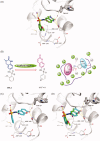Discovery of novel coumarin derivatives as potent and orally bioavailable BRD4 inhibitors based on scaffold hopping
- PMID: 30879350
- PMCID: PMC6427567
- DOI: 10.1080/14756366.2019.1587417
Discovery of novel coumarin derivatives as potent and orally bioavailable BRD4 inhibitors based on scaffold hopping
Abstract
The bromodomain and extra-terminal (BET) bromodomains, particularly BRD4, have been identified as promising therapeutic targets in the treatment of many human disorders such as cancer, inflammation, obesity, and cardiovascular disease. Recently, the discovery of novel BRD4 inhibitors has garnered substantial interest. Starting from scaffold hopping of the reported compound dihydroquinazolinone (PFI-1), a series of coumarin derivatives were designed and synthesised as a new chemotype of BRD4 inhibitors. Interestingly, the representative compounds 13 exhibited potent BRD4 binding affinity and cell proliferation inhibitory activity, and especially displayed a favourable PK profile with high oral bioavailability (F = 49.38%) and metabolic stability (T1/2 = 4.2 h), meaningfully making it as a promising lead compound for further drug development.
Keywords: BRD4 bromodomain; Rational drug design; biological evaluation; synthesis.
Figures










Similar articles
-
Design, synthesis and biological evaluation of coumarin derivatives as potential BRD4 inhibitors.Bioorg Chem. 2022 Nov;128:106117. doi: 10.1016/j.bioorg.2022.106117. Epub 2022 Aug 29. Bioorg Chem. 2022. PMID: 36063752
-
Discovery and structure-activity relationship studies of N6-benzoyladenine derivatives as novel BRD4 inhibitors.Bioorg Med Chem. 2015 Mar 1;23(5):953-9. doi: 10.1016/j.bmc.2015.01.022. Epub 2015 Jan 28. Bioorg Med Chem. 2015. PMID: 25678016
-
Discovery of a series of dihydroquinoxalin-2(1H)-ones as selective BET inhibitors from a dual PLK1-BRD4 inhibitor.Eur J Med Chem. 2017 Sep 8;137:176-195. doi: 10.1016/j.ejmech.2017.05.049. Epub 2017 May 27. Eur J Med Chem. 2017. PMID: 28586718
-
Inhibition of BET bromodomains as a therapeutic strategy for cancer drug discovery.Oncotarget. 2015 Mar 20;6(8):5501-16. doi: 10.18632/oncotarget.3551. Oncotarget. 2015. PMID: 25849938 Free PMC article. Review.
-
Novel approaches to targeting BRD4.Drug Discov Today Technol. 2017 Jun;24:19-24. doi: 10.1016/j.ddtec.2017.10.003. Epub 2017 Oct 28. Drug Discov Today Technol. 2017. PMID: 29233295 Review.
Cited by
-
Dual PI3K/Akt Inhibitors Bearing Coumarin-Thiazolidine Pharmacophores as Potential Apoptosis Inducers in MCF-7 Cells.Pharmaceuticals (Basel). 2022 Mar 31;15(4):428. doi: 10.3390/ph15040428. Pharmaceuticals (Basel). 2022. PMID: 35455425 Free PMC article.
-
Design, Synthesis and Preliminary Biological Evaluation of Benzylsulfone Coumarin Derivatives as Anti-Cancer Agents.Molecules. 2019 Nov 7;24(22):4034. doi: 10.3390/molecules24224034. Molecules. 2019. PMID: 31703373 Free PMC article.
-
Design, synthesis, and biological evaluation of coumarin derivatives against tuberculosis: a pharmacophore-based approach.Mol Divers. 2025 Aug 20. doi: 10.1007/s11030-025-11293-5. Online ahead of print. Mol Divers. 2025. PMID: 40833436
-
Latest developments in coumarin-based anticancer agents: mechanism of action and structure-activity relationship studies.RSC Med Chem. 2023 Oct 20;15(1):10-54. doi: 10.1039/d3md00511a. eCollection 2024 Jan 25. RSC Med Chem. 2023. PMID: 38283214 Free PMC article. Review.
-
Immunostimulants for shrimp aquaculture: paving pathway towards shrimp sustainability.Environ Sci Pollut Res Int. 2023 Feb;30(10):25325-25343. doi: 10.1007/s11356-021-18433-y. Epub 2022 Jan 13. Environ Sci Pollut Res Int. 2023. PMID: 35025041 Free PMC article. Review.
References
-
- Lolli G, Caflisch A. High-throughput fragment docking into the BAZ2B bromodomain: efficient in silico screening for x-ray crystallography. ACS Chem Biol 2016;11:800–7. - PubMed
-
- Padmanabhan B, Mathur S, Manjula R, Tripathi S. Bromodomain and extra-terminal (BET) family proteins: new therapeutic targets in major diseases. J Biosci 2016;41:295–311. - PubMed
MeSH terms
Substances
LinkOut - more resources
Full Text Sources
Other Literature Sources
